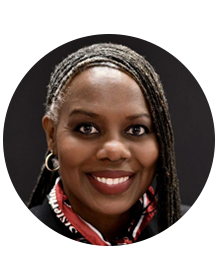The Unheard Word: Volume II
About The Unheard Word II
Have You Heard the Word?: Reflections on the Past to Push Forward
By Riva Brown, Ph.D., ’93, ’98, ’13
I thought I was done with The Unheard Word back when I earned my undergraduate degree. I packed away my copies and had no plans
to look back. Ever. That was spring 1993.
After all, the publication had accomplished objectives it set in fall 1990: Educate readers about Clyde Kennard and ensure that the University of Southern Mississippi formally acknowledged him.
Then-President Aubrey K. Lucas issued a public apology and renamed the Student Services Building as Kennard-Washington Hall. It bears the name of Kennard and Dr. Walter Washington, the first Black student to earn a Ph.D. from Southern Miss. That also was spring 1993.
But everything changed with the racial reckoning of summer 2020, when more white folks on college campuses and across the country began to wake up to realize that Black lives indeed matter.
Could The Unheard Word reach these newly woke folks? Could it connect Black students and Black alumni? Could it raise awareness about the Center for Black Studies? Could it encourage donors to support the Kennard Scholars program? Answering those questions was worth unearthing those old editions and enlisting a dream team to find out.
Volume two hits during Black History Month, after a particularly tumultuous presidential election and Congressional certification where Vice President Kamala Harris made history as the first woman, Black woman and South Asian woman to hold that powerful position.
It hits after a deadly insurrection where mostly white domestic terrorists stormed the U.S. Capitol, one proudly waving the Confederate flag, a racist symbol that no longer emblazons Mississippi's state flag.
Thirty years ago, you couldn't have convinced me that a student organization, the Southern Miss Association of Black Journalists (SMABJ), could recruit a multiracial group of undergraduate and graduate students to revive The Unheard Word. And you couldn't have made me believe that peers I hadn’t seen nor heard from in years, in some cases decades, would immediately agree to be featured. I’m beyond grateful.
Today, as Black History Month draws to a close and we conclude this commemoration of the creation of The Unheard Word 30 years ago, I offer these nine reflections as a guide to volume two.
1.
THEN: My goal was reaching all Black college students on the Southern Miss campus. Just us. If the message resonated with white folks, older folks, all good. But my target population was clear.
NOW: Reaching Black alumni I attended college with three decades ago is tricky. Reaching
Black students I don’t know, in a state where I don’t live, on a campus where I don’t
teach, is even trickier. Reaching other races is the trickiest. But we could not,
and would not, be deterred.
2.
THEN: Black students and community leaders wrote forThe Unheard Word. From history to think-pieces, the publication gave them a place to see their prose and poetry in print.
NOW: Earl Stoudemire, SMABJ president and aspiring broadcast journalist, wrote the primary piece for this volume. His work, and the work of students who created the white privilege and All Lives Matter videos, captures the heart and soul of the original Unheard Word. Earl is a part of a new generation -- white, Black and Latinx -- that eagerly and excitedly created content for this revival.
3.
THEN: Two “Profiling Black Excellence” sections celebrated our on-campus success. ON THE MOVE commended freshmen, while AGAINST THE ODDS honored upperclassmen. I included their photos so readers could see images of excellence.
NOW: SMABJ selected an outstanding Black student from each of the four colleges on campus. We’ve evolved to videos so viewers can also hear what excellence sounds
like.
4.
THEN: I was so proud of my peers that I just had to praise them in print. I had absolutely no doubt that they all would continue to achieve greatness long after they left Southern Miss.
NOW: I'm even prouder of all my fellow alumni featured in Where Are They Now?. Whether their profession is education or economic development, ministry or law,
all have continued to excel. I hope their wise words and life lessons motivate the
new generation as much as they moved me.
5.
THEN: I was taught by two Black teachers -- one in junior high, the other in high school. Both taught English. Both encouraged me after I graduated. But I never had a Black professor as a Southern Miss undergrad. I ached to see the faces of educators who looked like me. So I sought them out for FACULTY SPOTLIGHT profiles.
NOW: I teach at a predominantly white institution. I choose to believe that my presence
makes a difference for Black students -- for all students -- I encounter. The Unheard Word profiles all of the full-time Black faculty on Southern Miss’ Hattiesburg campus. The fact that the number of Black students has more than doubled since I was an undergrad, but the number of Black faculty has barely budged, speaks volumes.
6.
THEN: Readers knew The Unheard Word was on the way because I hung hand-lettered red, black and green butcher paper signs that read, “Have you heard? The WORD is coming?” They knew it had arrived because the new signs read, “Have you heard? The WORD is out!”
NOW: Our promotional pieces are animated social media graphics using the same colors and words, with an image from the cover of the final edition published in spring 1993.
7.
THEN: My crew and I dressed in all black with African kente cloth accents and hand-distributed
The Unheard Word on the Southern Miss campus. But I dreamed of distributing the publication to all
Black college students across the state of Mississippi
NOW: Thanks to the wonders of modern technology, the internet, this publication has the
potential to reach Black college students -- college students period -- across the
state and around the country during a global pandemic.
8.
THEN: After I learned the Clyde Kennard story, I felt compelled to use The Unheard Word to educate Black students about him. They needed to know about his ultimate sacrifice after futile efforts to further his education.
NOW: I hope readers will honor Clyde Kennard’s legacy in their own way. Dr. Eddie A. Holloway, dean of students-emeritus, tells his story of carrying on the legacy of a man he learned about as a boy. Decades later, as an administrator at his alma mater, he created the Kennard Scholars program. His one wish is to see the program expand so more standout students can get the mentorship and money they need to graduate.
9.
THEN: As I’ve said before, I was laser-focused on educating readers about Clyde Kennard and urging the Southern Miss administration to properly honor his legacy.
NOW: I hope alumni and friends will help future Kennard Scholars continue to live out his
legacy. Several former ones share how the Kennard Scholars program has impacted their lives.
Please join me in supporting the Kennard Scholars program as a way of honoring a proud and intelligent Black man -- a man who lost his life in his unyielding quest for higher education at what is now Southern Miss.
The late Oseola McCarty, a Black washerwoman who donated $150,000 of her life savings to Southern Miss for scholarships, sums up my sentiments in her book, Simple Wisdom for Rich Living: “I am proud that my money will help young people who have worked hard to deserve it. I’m proud that I am leaving something positive in this world. My only regret is that I didn’t have more to give.”
➤ To comment on this spring 2021 article, visit the Center for Black Studies on Facebook.
➤ To give and support the Kennard Scholars, visit the USM Foundation.
 Riva Brown, Ph.D., ’93, ’98, ’13, a former journalist, is an associate professor of public relations at the University of Central Arkansas in Conway. |
Go back to The Unheard Word page
“Notes of a Native Son”: Being Young, Black, and Proud
By Earl Stoudemire, ’21
One expression that I can say to describe this experience, simply put, is that it
has been a joyride. Last semester when I was serving as vice president of the Southern
Miss Association of Black Journalists, I was excited to hear the backstory of this
publication by Dr. Riva Brown to support a then-smaller community of Black scholars
at USM. With all things Black being represented in this publication in a positive
light, it gives me pride to say I was a part of this revival edition to support the
community that I come from.
I had an interesting life growing up, but it has led me to where I am today. Growing
up as a Black military child, finding a place of belonging was hard to achieve. My
parents were always there, but there were times I felt alone, unheard, and uncared
for. With the larger schemes of the world outside of home, hatred, judgment, and prejudice
existed just walking outside of the door as a Black boy.
I always questioned the treatment of others based on race alone. The answers were
too big to ignore, watching the media portraying me as something I’m not. What became
my distraction from life watching television news on cable as a child soon became
my focus, changing it for the better.
We live in a white-supremacist-capitalist-patriarchy, and there is no discussion around
this viewpoint. The media is a business at the end of the day, and it is run by money.
With many funders of the media funneling cash into the production pipeline for what
is written, shot, edited, created and shared, agenda setting becomes prevalent for
what the average citizen thinks subconsciously over time.
If you are not a white, heterosexual, Christian, male, there is something against
you, and the intersectionality of all of the identities you claim, or are born into,
separates you further from the fair treatment and equality everyone is promised as
citizens in this country.
Challenging the status quo is something I strive to do every day to break the hegemony
of past forces placed upon me at birth for a better future for generations coming
after me. We currently live in a period where racism, discrimination, and prejudice
is in full force and even accepted in mainstream culture, not being hidden in the
shadows like before. The solution of breaking away from errors of the past is by building
and embracing a future of true diversity, equity, and love for all mankind.
Working on this project under Dr. Riva Brown, Dr. Cheryl Jenkins and Dr. Sherita Johnson
-- all intelligent, strong, beautiful Black women -- has been an awesome learning
experience under their guidance. In turn, growing as a leader working with my peers
on a project I have a deep passion for has pushed me to my limits for the better.
Some days definitely have been rough balancing work, social life, school, extracurriculars,
and preparing for post-graduation life looking for jobs, but I would do it all again
knowing that I’m able to leave Southern Miss better than how I found it one last time.
➤ To comment on this spring 2021 article, visit the Center for Black Studies on Facebook.
➤ To give and support the Kennard Scholars, visit the USM Foundation.
|
Earl Stoudemire is a senior broadcast journalism/Spanish double major from Clinton, Mississippi. He is expected to graduate from USM in May 2021, and his plan after graduation is to pursue reporting opportunities in larger metropolitan areas. |

